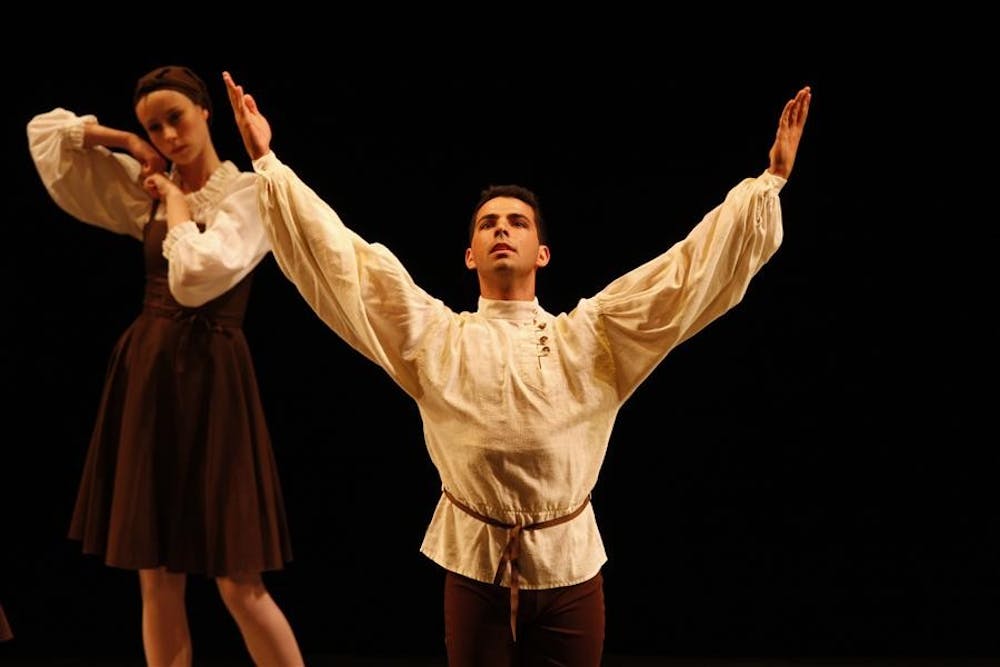Grace and elegance paid tribute to iconic figure Sergei Diaghilev as the IU Ballet Theater presented its fall ballet this weekend.
“It was fabulous,” said audience member Heather Rosenfeld. “They’re just phenomenal.”
The ballet began with back-to-back performances of “Valse Fantasie,” both choreographed by George Balanchine, who is known as ballet’s foremost contemporary choreographer. The first, created in 1953, is a clear representation of neo-romanticism, while the second, from 1967, falls into the neoclassical style.
Full of the requisite lifts, jumps and turns, not to mention time spent en pointe, most people would expect from a ballet, there were also minute details, such as the simultaneous graceful flick of a wrist or gentle wave of a hand from each dancer.
While the “Valse Fantasie” performances relied largely on aesthetics to keep the audience’s attention, trusting in the sheer beauty of the movements, the second two ballets gave the crowd plot lines and characters to follow.
“Jeux,” choreographed by department chair Michael Vernon, featured a tennis theme, with the three principles and four corps de ballet members in tennis white, occasionally using rackets as dance props. The principles formed a love triangle, which resulted in the two women dancing offstage, leaving the man behind and confused.
The Russian wedding, “Les Noces,” was full of simple costumes, backdrops and seemingly harsher motions than the long, gliding movements of the previous ballets. While no less well-done, the contrast highlighted the apprehension and fear of the bride.
Whereas before there had been no more than seven people on stage at a time, “Les Noces” utilized a larger corps de ballet, resulting in no fewer than 11 at once. The grand finale of “Les Noces” required 30 dancers in the corps, often all moving in unison, while the bride, groom and their parents looked on from a raised platform upstage.
“‘Les Noces’ isn’t the kind of thing you go home whistling,” said Howard Sayette, the regisseur responsible for accurately re-staging the ballet. He explained that it is very complex, and therefore both the music and choreography are difficult to teach. Despite the ballet’s complexity and that he was working with students rather than professionals, Sayette said he was pleased with the result.
“I thought they did beautifully,” he said. “The music was incredible.”
Emily Rosenfeld, a sophomore at the Indianapolis School of Ballet, said she was most impressed by the choreography and musical flow of “Valse Fantasie.”
“They were all really good, but that was my favorite,” she said.
During a pre-show talk, visitors heard insight into the creative process behind the ballets from speakers such as guest artists Sayette and Marina Eglevsky, the regisseur for the 1953 “Valse Fantasie.”
“The dancers here have really done a beautiful job, and it was wonderful to work with them,” Eglevsky said.
Vernon also spoke, as did professor Violette Verdy, the ballet mistress for 1967 “Valse Fantasie,” who said she was “delighted to have been a part of this.”
Because Diaghilev’s collaborative nature is such a huge part of his legacy, Vernon said this show was a major collaboration with other groups and departments, notably the Contemporary Vocal Ensemble and the University Singers.
“It really is in the spirit of Diaghilev,” he said.
Ballet captures grace en pointe

Get stories like this in your inbox
Subscribe





